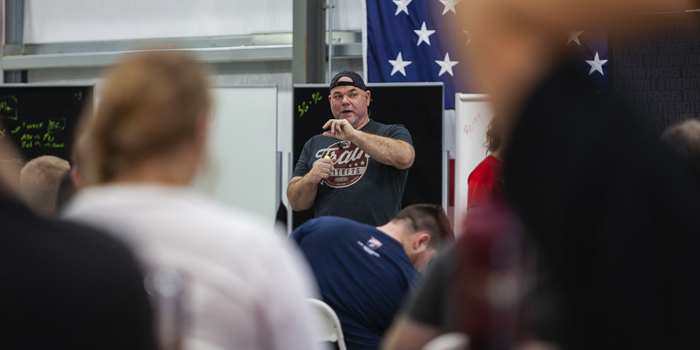
The elitefts Learn to Train X (LTTX) seminar took place in early August, bringing together trainers, coaches, athletes, and competitors across the powerlifting industry for the intensive three-day event. Participants were able to attend lectures from respected strength and performance educators, and also had the opportunity to experience hands-on instruction at training stations dedicated to perfecting squat, bench press, and deadlift techniques. To kick off the lecture series, Dave Tate presented to the group on how he developed his personal training philosophy, and how it has evolved over the course of his career.
WATCH: Learn to Train X — Practice Pelvis Correction for a Stronger Squat
With this year marking the 20th anniversary of elitefts, Tate acknowledges the significance of the timing of the LTTX seminar for his team, reflecting back on the success of the company in a market where this is not necessarily the norm. In this presentation, Tate shares more about his journey to find success in the powerlifting industry and recognizes the key methodologies and people that shaped his present-day training philosophy.
Lifelong Dedication to Powerlifting
In a nod to the 20th anniversary of elitefts and his many years of conducting training seminars, Tate decides to pull content for this lecture from one of his past presentations. Although the information he presents dates back to 1996, the majority of it still applies today, and allows Tate to highlight the elements that have advanced and evolved since then.
Ever since he was young, Tate’s thoughts were totally consumed by powerlifting. He explains that he started his powerlifting training at just 12 years old, and was competing in the sport just one year later. He helped train his high school football team, worked as a personal trainer, and devoured everything that the library had to offer on powerlifting methodology and nutrition. When Tate went off to college, powerlifting remained his number one priority – so much so, that it took him eight years to obtain his bachelor’s in Exercise Science and Nutrition.
In the early 90’s, Tate moved to Columbus, Ohio to train at Westside Barbell with Louie Simmons, whom he had known since he was young. He became a personal trainer and remained there for eight years. As Tate explains, he was essentially in the gym from 6 AM-10 PM every Monday through Saturday for eight years. Not only was powerlifting his career, it was his life. As his dedication to the sport grew stronger, Tate explains that he constantly had to defend his passion to others who didn’t see powerlifting as a viable career choice.
Through every phase of my life, I’ve had people say, ‘What are you going to do with this powerlifting stuff’? This is before personal training was a profession. You were either sports management…or a fitness instructor. There was no real career path, but that was still the direction that I kept going because that’s what I loved to do.
As Tate reflects, smiling, he says that now he is fifty years old and nobody asks him those kinds of questions anymore. As for Tate and elitefts, the proof is in the pudding. Tate’s perspective is that as long as someone is persistent, over time they will figure it out and find success – a statement which certainly rings true for him.
Training the “Average Gym Rat”
Tate explains that roughly a decade ago, elitefts moved out of their original location and hit an inflection point. His team wanted to bring in a group of people to train, and as Tate recounts it, he was initially opposed to the idea. After some persuasion, Tate agreed – under one condition. He explains that he did not want to work with a group of people whose number one priority was powerlifting because he did not want to deal with that kind of a mentality.
Rather, his goal was to take the “average gym rat” and make them Elite/Pro. Furthermore, Tate notes that he wanted to accomplish this mission without the extreme rules that are typically involved in serious powerlifting training. This would not be a training environment in which an athlete is thrown out of the program if they decide to go on vacation, or are not at the gym by 9 AM sharp every day. Yet, this meant that Tate was dealing with a different clientele: people who had, as he puts it, “real jobs”:
So, what I had to deal with was people who had ‘real jobs’ … I had to structure a training program with most of the heavy stuff on Saturday and Sunday, with Friday and Monday being off days…If they [couldn’t] get out to train during the week, what could I have them do at any gym that doesn’t involve a spotter, [that] doesn’t involve somebody with a technical eye and all these other things.
The first hurdle that Tate encountered was that with this type of program structure, he could not use the Conjugate method. Instead, initially, he had to flex his coaching style and fall back on more of a Block training program. Nevertheless, Tate notes that this ability to adapt was key, and proved to be successful as the athletes with whom he worked all went on to achieve Elite/Pro totals. Tate qualifies, however, that his particular programming was designed specifically for 3-4 people, as opposed to a larger group of trainees.
Awareness of Training Biases
A key learning point that Tate reiterates is the importance of identifying training biases in the sport of powerlifting. He explains that he himself is aware that he has a training bias that’s Conjugate-based – but he knows this about himself and accounts for that in training when needed. The issue is that many coaches and athletes are completely unaware that they possess biases towards certain training programs and methodologies. Although, as Tate breaks it down, all programs pull from one (or more) of the three foundational training sectors:
To be able to move, and to coach, and to help other people in the strength field or in powerlifting…You’d better learn what Linear Periodization (or the Western Method of Periodization) is, you’d better learn what Block Periodization is, and you’d better learn what Conjugate Periodization is…I don’t care what the program is, it all falls in one of those three sectors.
This does not mean that one sector is necessarily better than the others; Tate notes that he has seen people advance in all three of them. The main takeaway is that coaches must be ready to flex their approach when training athletes that are already seeing success in working with a particular style.
Don’t Be the Stupid Fly
As he wraps up the session, Tate concludes with one of his favorite analogies for training that still applies after all of these years. He gestures to a graphic on the screen depicting a fly:
Flies are attracted to light. Flies are trying to go to that window, banging against that glass over and over…They know where they want to go, but they’re so stubborn…Meanwhile, if they just turned around and looked, there’s an open door right there — they can fly and get where they want to be.
To summarize: don’t be the stupid fly. Trainers, athletes, and coaches should always be looking for opportunities to pivot in their programming if need be. In doing so, they might just discover the door to success.









